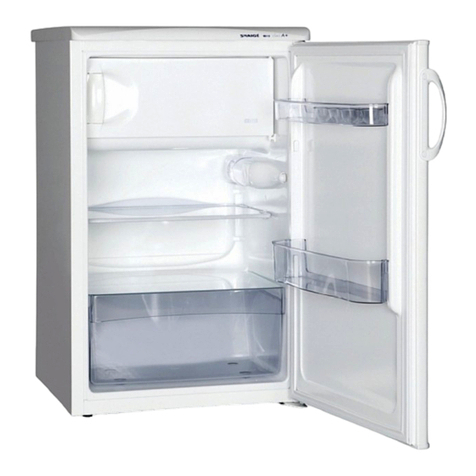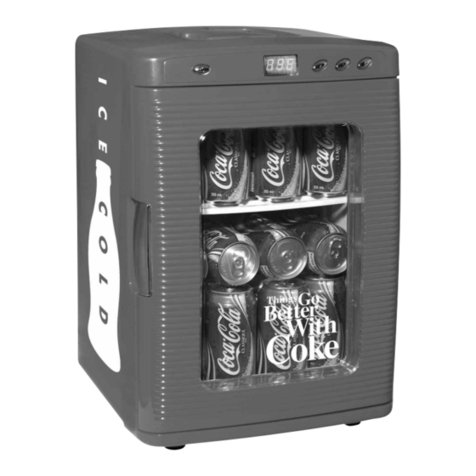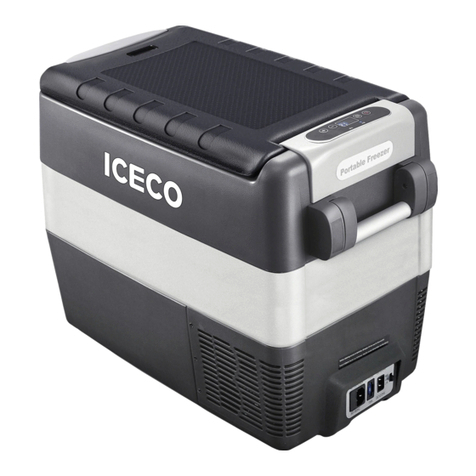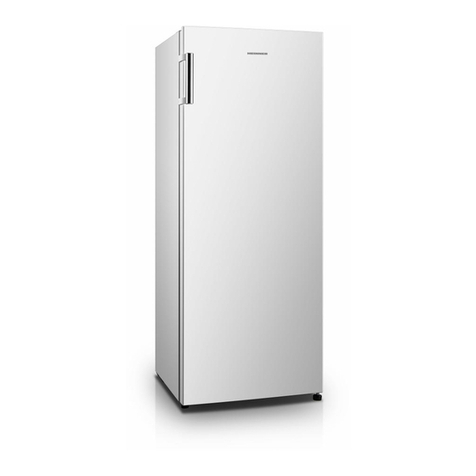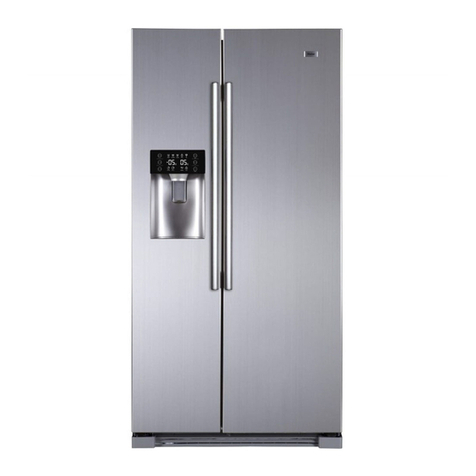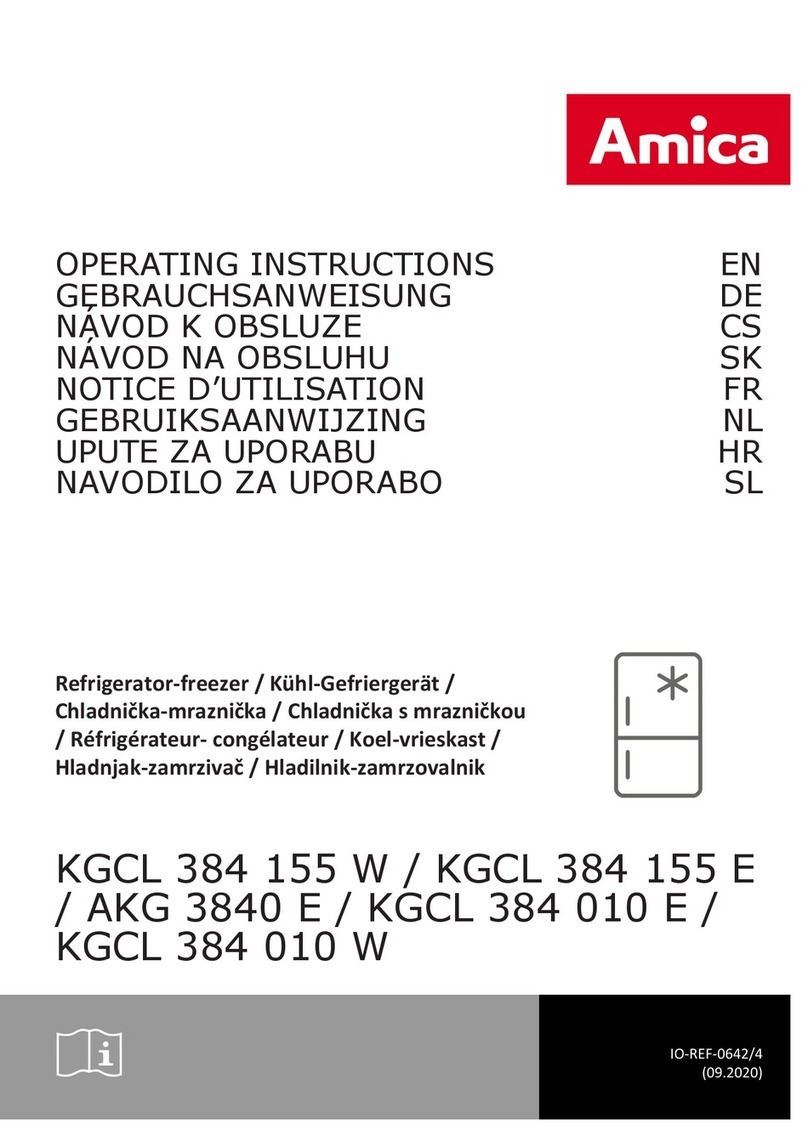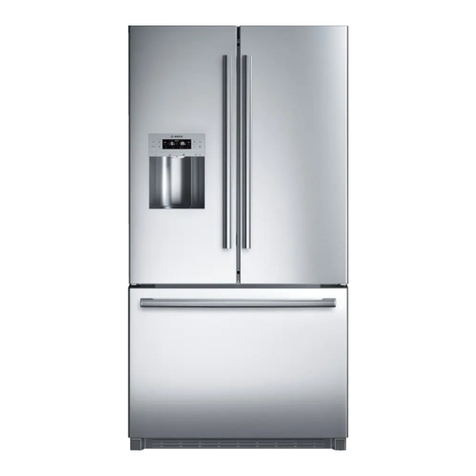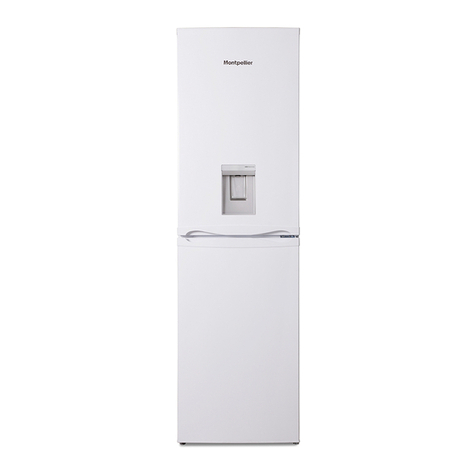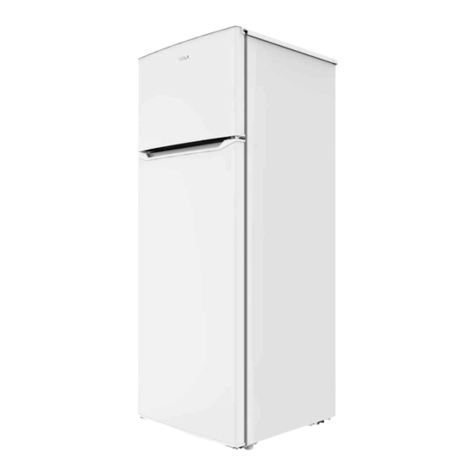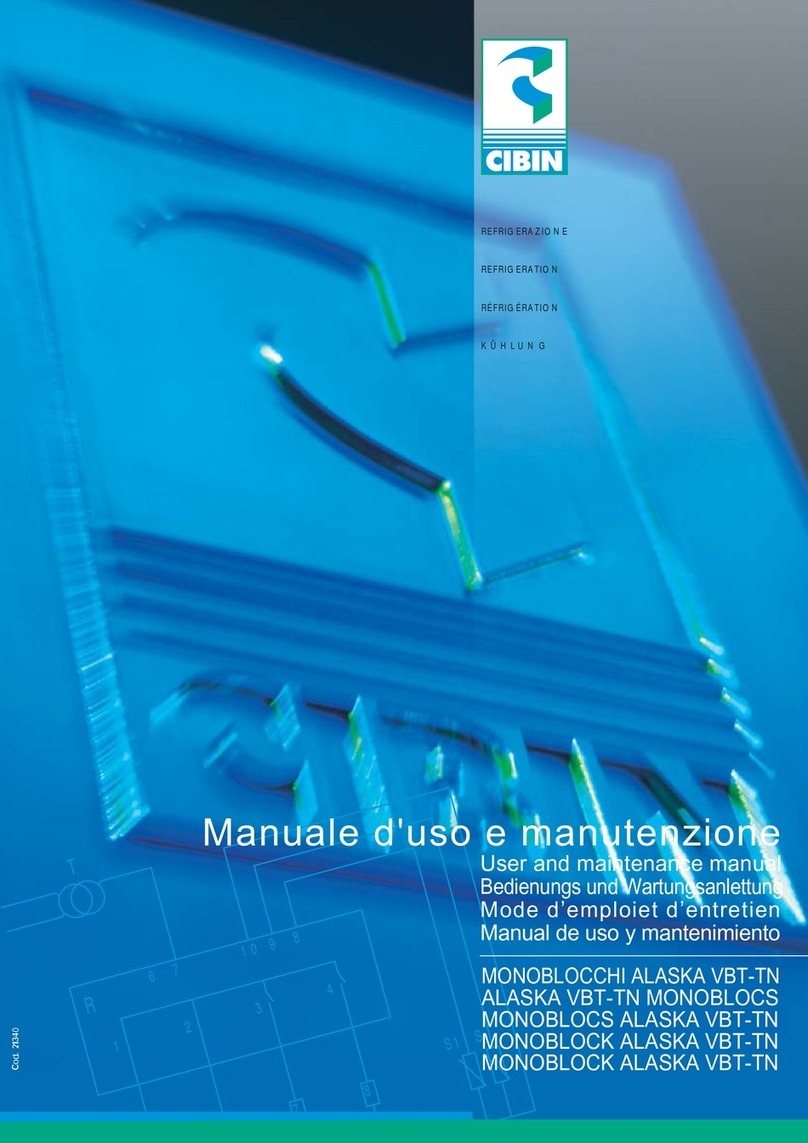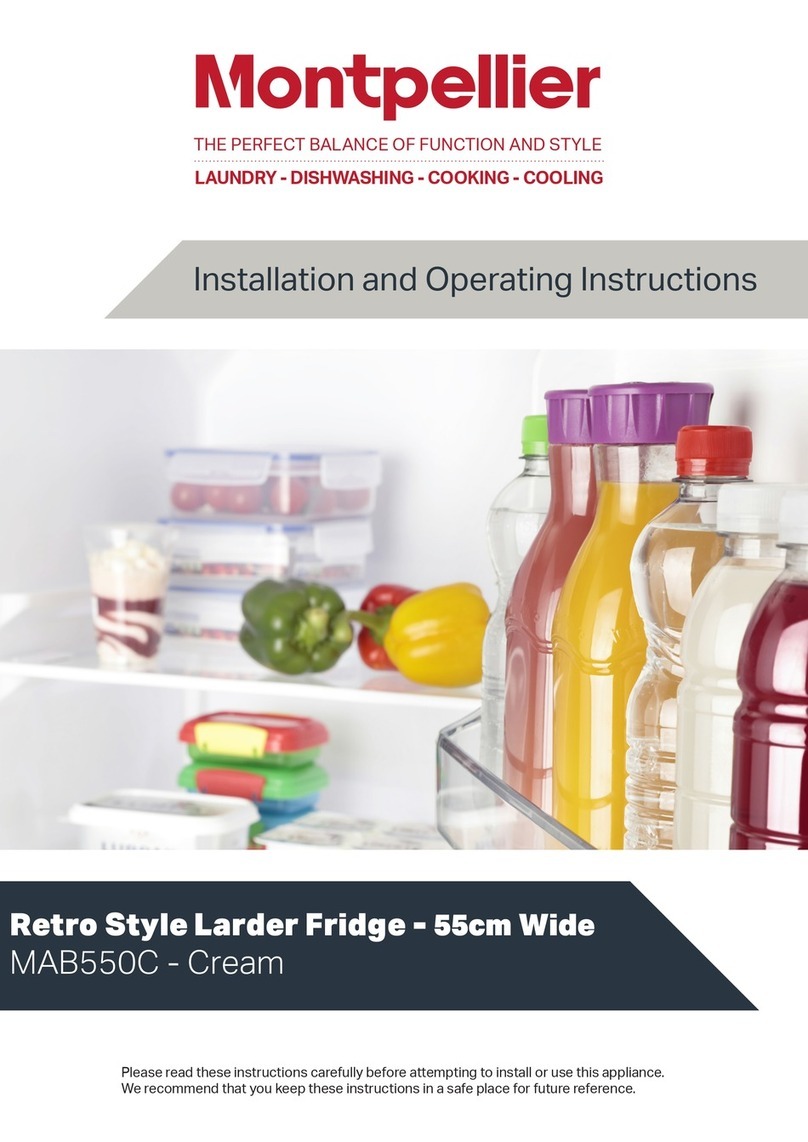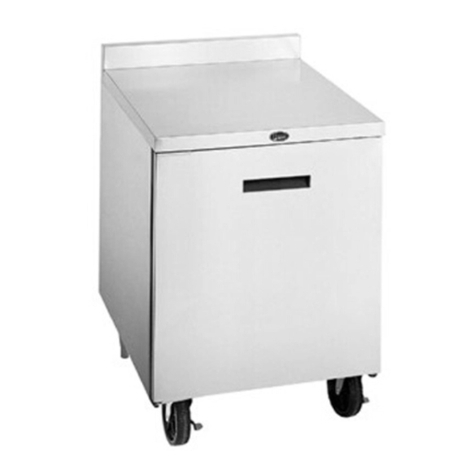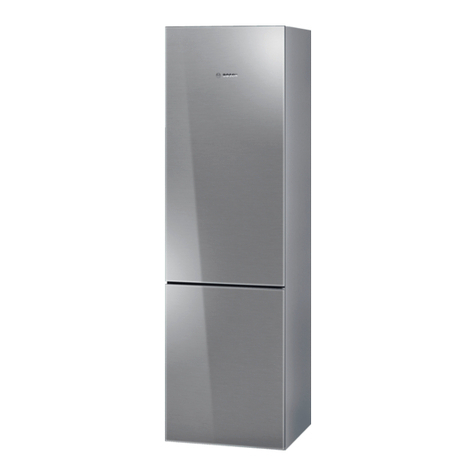SNAIGE CD40DM User manual

BEVERAGE REFRIGERATOR
Instruction for Use

1
DEAR CUSTOMER!
CAREFULLY READ THE INSTRUCTION MANUAL. If instructions are not followed, there is a
risk of injury, damage of the appliance and loss of the right to free warranty service.
The Manufacturer shall not be held liable for damage arising from the failure to observe
the instructions contained in this manual.
Keep this manual for future reference, or to pass it over to the next user.
General information:
The appliance is a vertical beverage refrigerator with glass doors and with a fan and is
designed for cooling and storing bottled beverages only.
This appliance is intended for commercial use!
THE MANUFACTURER GUARANTEES RELIABLE OPERATION OF THE BEVERAGE
REFRIGERATOR WHEN THE AMBIENT TEMPERATURE IS +16 TO +32 DEGREES CELSIUS
AND THE RELATIVE AIR HUMIDITY NOT GREATER THAN 60 PER CENT.
GUIDELINES CONCERNING THE SAFETY OF USE
General safety requirements:
–WARNING: Keep ventilation openings, in the appliance enclosure or in the built-in
structure, clear of obstruction.
–WARNING: Do not use electrical appliances inside the food storage
compartments of the appliance, unless they are of the type recommended by the
manufacturer.
–WARNING: When positioning the appliance, ensure the supply cord is not
trapped or damaged.
–WARNING: Do not locate multiple portable socket-outlets or portable power
supplies at the rear of the appliance.
WARNING: Do not damage the appliance refrigeration system. It contains
the refrigerant gas R600a. If the refrigeration system is damaged:
•Do not use any open flame.
•Avoid sparks-do not turn on any electrical appliances or lighting fixtures.
•Immediately ventilate the room: air the room in which the appliance is placed for a
few minutes (the size of the room for a product containing isobuthane / R600a
must be at least 4 m3) to avoid damage to the cooling system.
C-Pentane is used as blowing agent in the insulation foam and it is a
flammable gas.

2
–WARNING: Disposal of the appliance should be according to national rules.
–This appliance is not designed for the storage of explosive substances such as
aerosol cans with a flammable propellant.
–It is prohibited to store petrol and other flammable liquids near the appliance.
–The appliance should be used only for storing foodstuffs.
Children and vulnerable people safety:
–Do not allow children to play with the packaging material from the appliance.
–This appliance can be used by children aged from 8 years and above and persons
with reduced physical, sensory or mental capabilities or lack of experience and
knowledge if they have been given supervision or instruction concerning use of the
appliance in a safe way and understand the hazards involved.
–Children aged from 3 to 8 years are allowed to load and unload refrigerating
appliances.
Requirements for the connection to the mains:
–The appliance should only be connected to an earthed socket installed in
accordance with the regulations. Make sure that the supply voltage corresponds
with the voltage marked on the rating label. This product complies with all binding
CE labelling directives. The earthed electrical socket by which the appliance is
connected to the mains should be in an accessible place. It is a legal requirement
that the appliance is properly earthed. The manufacturer will not be held liable for
any damage or injury which may result from the failure to fulfil this requirement.
–To avoid the exposure to danger, always have faulty cable be replaced only by
the manufacturer, by our customer service or by qualified person and with a cable
of the same type.
–It is forbidden to readjust or modify any parts of the unit. It is crucial not to
damage the capillary tube visible in the compressor recess. The tube may not be
bent, straightened or wound. If the capillary tube is damaged by the user the
guarantee will be void.
–Do not use adapters, multiple sockets and two-wire extension leads. If it is
necessary to use the extension lead, it must be equipped with a protection ring
and a single socket and must have a VDE/GS safety certificate. If an extension
lead is used (with a protection ring and safety certificate), its socket must be
located at a safe distance, away from the sinks, and must not be in a place where
it could be flooded by water or waste water.
–The frequency and power of the electricity supply in your house must conform to
the general data parameters of the appliance as it is shown in the product label.

3
–When positioning the appliance, be careful that the electrical cord isn’t squeezed
in order to avoid its damage. Do not store heavy objects such as cooling devices
or other devices next the appliance in such a way that they could squeeze and
damage the electrical cord. This can cause a short circuit and a fire.
–Make sure that the plug of the electrical cord is not squeezed by the back wall of
the appliance or otherwise damaged. A damaged plug can be the cause of a fire!
CAUTION! If the installed interior lighting or the advertising panel’s light-
emitting diode (LED) lamp for the cooling device is not functioning, contact
the maintenance and repair representative for replacements. Lamps can be
replaced only by the maintenance and repair representative
Do not try repair the appliance on your own. Always contact an authorized
technician. To avoid the exposure to danger, always have faulty cable be
replaced only by the manufacturer, by our customer service or by qualified
person whit a cable of same type.
Requirements for safe use:
–It is forbidden to use a technically damaged appliance.
–If the appliance is unplugged (for cleaning, moving to another place, etc.), it may
be repeatedly switched on after 15 min.
–When performing activities, such as cleaning, maintenance or moving, the
appliance must be completely disconnected from power supply (by pulling the plug
out from the socket). Do not pull on the cord, but hold the body of the plug
instead.
–Do not place any switched on electrical devices on top of the appliance because
this may cause ignition of plastic parts.
–Do not place any dishes with liquids on top of the appliance and do not keep
flowers in vases or other liquid-filled vessels on the appliance.
–Do not climb on or sit on the appliance, do not lean on or hang on the appliance
doors and do not allow children to do this.
–Do not use water spray and steam to clean the appliance.
The appliance should be transported in the vertical position. The
manufacturer will not be responsible for any damage of the appliance that
results from non-compliance with the instructions for transportation.

4
INSTALLATION AND OPERATING CONDITIONS
Positioning:
•This appliance can be installed in a dry, well ventilated indoor where the ambient
temperature corresponds to the climate class indicated on the rating plate of the
appliance.
Do not install this appliance in areas that are too humid or too colds,
such as the construction appendices, garages or wine cellars. Place
the appliance away from heat sources such as kitchen stove/oven,
radiators, or direct sunlight. The appliance must not touch any pipes
for heating, gas or water supply, or any other electrical devices.
Minimum distances from the heat sources:
- from the electric gas and other ovens - 30 mm,
- from oil or coal fired ovens - 300 mm,
- from built-in ovens - 50 mm
If there is no possibility of ensuring the above- mentioned distances, provide an
appropriate insulation board.
•Do not cover the ventilation holes at the
top of the appliances –it must be a
good air circulation around the
appliance. There should be a gap of at
least 10 cm between the top of the
appliance body and any furniture that
may be above it. If this requirement is
not followed, the appliance consumes
more electrical energy and its
compressor may overheat.
•If the appliance is placed in a corner, a
gap of at least 1 cm must be left
between the appliance body and the
wall.
•The appliance must stand on a level
surface and must not touch the wall. If necessary, regulate the height of the appliance
by adjusting the levelling feet: by turning them clockwise –the front of the appliance
rises, by turning them counter clockwise –it comes down. If the appliance is tilted
slightly backward –the doors will close by themselves.
Preparing for operation:
•It is recommended to prepare the appliance for operation with a helper.
•Remove package. Lift the appliance away from foamed polystyrene base.Therefore take
out adhesive tapes from sides and simply lift the appliance up and take out the board.
Strip adhesive tapes off and open the door. Remove the spacer above the door.
•When positioning the appliance in chosen location, it will move more easily into position
if you lift the front a little and incline it backward allowing it to roll on its casters.

5
•When placing, moving, lifting the appliance, do not hold the door handles, do
not pull the condenser at the rear part of the refrigerator and do not touch the
compressor unit.
•The appliance should not be connected to the mains until all packing and
transport materials aren’t removed. Suitably dispose the packaging material.
First use:
•Before using the appliance for the first time, the interior and all internal accessories
should be washed with lukewarm water and some neutral soap to remove the typical
smell of a brandnew product, then dried thoroughly.
•The unit should only be transported in its vertical position; do not tilt any more than
30°.
•Once the unit has been positioned, wait for about 30 minutes before it is connected to
the mains.
If the unit has been tilted more than 30° during transport:Wait at least 4
hours before connecting the appliance to the power supply. If this is not
done, the appliance compressor may fail.
•When first starting-up or after a period out of use, before putting the products in the
compartment let the appliance run at least 2 hours.

6
DESCRIPTION OF THE APPLIANCE, BASIC PARTS
The appliance accessories listed below may differ from the accessories of the
appliance you have bought in quantity and in design. This description is adapted for
entire group of refrigerator-freezer.
1
Advertising panel
6
Fan. The fan for the appliance is
activated and operates
continuously!
2
Thermostat - temperature
regulator
7
Shelves
3
Interior lighting on/off button
Symbol “|”:on; “O”: off
8
Condenser
4
Advertising panel light on/of
button. Symbol “|”:on; “O”: off.
9
Thaw water drip tray
5
LED lighting
10
Compressor

7
TEMPERATURE REGULATION
The appliance is activated by connecting it to the mains.
The temperature in the appliance is controlled using the thermostat knob 2(see fig. 1) by
turning it to one side or the other. Turning the thermostat dial clockwise reduces the
temperature in the appliance. The temperature indication in digits is shown beside the
thermostat knob. The number “0, 2, 3, 4, 5”do not mean a specific temperatures.
The temperature can be set within a 0 °C to +10 °C range.
The temperature is regulated on a scale of five digits.
0= Compressor is switched off. WARNING! Electric current is not switched off.
With the temperature control in position ‘0’, only the compressor is switched off, while the
fan is still running.
1= highest temperature (lowest cooling)
5= lowest temperature (highest cooling)
If the room is cool, the appliance cools less. The temperature in the appliance may
therefore rise. Use the thermostat wheel to set a lower temperature.
THE TEMPERATURE IN THE APPLIANCE COMPARTMENT MAY VARY DEPENDING
ON AMBIENT TEMPERATURE, THE AMOUNT OF BEVERAGES, THE TEMPERATURE
OF THE BEVERAGES, AND HOW OFTEN THE APPLIANCE DOOR IS OPENED AND
CLOSED. Therefore we recommend:
•locate the appliance away from heat sources,
•beverages placed in the appliance should not be warmer than the room temperature,
•appliance door must not to be left open.
DEFROSTING, CLEANING AND CARE
THE REFRIGERATOR COMPARTMENT defrosts automatically. Drops of ice that form on the
back wall of the refrigerator compartment thaw during the time the compressor is not working
and the thaw water runs down the thaw water runoff channel to the tray on top of the
compressor (Fig. 1), where it evaporates.
REGULARLY CLEAN THE APPLIANCE.
Note: before cleaning the cooling device and its rear compartment part,
the device must be disconnected from the mains by unplugging.
•Protect the appliance inner surfaces and plastic parts from fats, acids and sauces. In
case of accidental spills –immediately clean with warm soapy water
or dishwashing detergent. Wipe dry.
•Regularly clean the hermetic gaskets of the doors. Wipe dry.
•At least once a year clean dust away from the back part of the
appliance body and the compressor. A soft brush, electrostatic cloth
or vacuum cleaner may be used for cleaning.
•Regularly clean the thaw water channel space in the refrigerator
with a special cleaner for that purpose (see fig.).

8
•DO NOT use detergents containing abrasive particles, acid, alcohol or benzene for
cleaning the appliance inner and outer surfaces. DO NOT use for cleaning cloths or
sponges that have coarse surfaces intended for scrubbing.
•If the appliance is to be left switched off for an extended period, leave its doors open.
CHANGING THE OPENING DIRECTION OF THE DOORS
It is recommended that changing the opening direction of the doors should be done with a
helper. You will need two spanners No. 8 and No. 10 and a head screwdriver.
When changing the opening direction of the doors, YOU CAN NOT lay the
refrigerator horizontally!
Warning: Always disconnect the unit from the mains before any maintenance or repair
work is carried out.
Before you start, please note the following:
∙ Always ensure that the correct number of washers is used on all hinge bolts and screws.
∙ So that the doors can close tightly against the frame, take the utmost care that they are
properly aligned during reassembly.
Do the actions below in the order they are listed (see fig.):
1. Turn off the appliance and pull the plug out of the electricity supply socket.
2. Remove the two screws (8) and separate the bottom bracket (10) together with the
washers and gaskets (9) on the small axle.
3. Remove the two screws (7)and separate the bracket (5) and the gasket (6).
4. Separate the door (4).
5. Remove the 4 screws (1) at the top of the advertising panel, separate the top of the
advertising panel (11), remove the front part of the advertising panel (12), and then
remove 4 screws (13) and separate the advertising panel; then loosen the 2 screws
(14) and transfer the upper bracket (15) to the other side. Assemble the advertising
panel in reverse order.
6. Turn the door 180°, insert the upper axle and mount the door on it.
7. Remove the mounting screws (2)from the door, separate the handle (3) and attach it
by screwing the screws into the holes on same side.
8. Using the supplied washers and gaskets, attach the lower bracket (10) on the opposite
side of the cooler, but first attach the bracket axle to the door. Screw in the bracket (5)
on the opposite side of the cooler.
CAUTION! Wait at least 4 hours before re-connecting the unit to the mains.

9
OPERATION PROBLEMS AND THEIR SOLUTIONS. What if …
•The appliance is plugged in to the mains but it does not work. Check if your
house electricity supply installations are in order. Check if the plug is correctly inserted
into the electricity supply socket.
•The noise has become louder. Check if the appliance is standing stable, on a level
place. To make it level, regulate the front feet. Check if the appliance is not touching
any furniture and if no part of the refrigeration system at the back part of the appliance
body is touching the wall. Pull the appliance away from any furniture or walls. Check if
the cause of increased noise isn’t due to bottles, cans in the appliance that might be
touching each other.

10
•Water has appeared at the bottom of the refrigerator compartment. Check
whether a thaw water channel space isn’t blocked. Clean the thaw water channel space
with a cleaner intended for that purpose.
•When the appliance door is opened, the rubber sealing gasket pulls out. The
gasket is smeared with sticky foodstuffs (fat, syrup). Clean the sealing gasket and the
groove for it with warm water containing soap or dishwashing detergent and wipe dry.
Put the rubber sealing gasket back into the place.
•High temperature in appliance, the compressor operation pauses are short.
Ascertain whether the appliance door/doors are shutting tightly, whether the door
wasn’t kept open longer than necessary when taking out or putting in foodstuffs or
whether a large amount of warm food was placed in the appliance.
•The top of the appliance has condensation on it. The ambient relative air humidity
is above 60 %. Ventilate the room where the appliance stands and if possible remove
the cause of the humidity.
ENVIRONMENTAL PROTECTION INFORMATION
Important Note:
This appliance is marked according to the European directive 2002/96/EC on Waste
Electrical and Electronic Equipment (WEEE). By ensuring this product is disposed of
correctly, you will help prevent potential negative consequences for the environment and
human health, which could otherwise be caused by inappropriate waste handling of this
product.
The symbol on the product, or on the documents accompanying the product,
indicates that this appliance may not be treated as household waste. Instead it
shall be handed over to the applicable collection point for the recycling of
electrical
and electronic equipment.
Disposal must be carried out in accordance with local environmental regulations for waste
disposal. For more detailed information about treatment, recovery and recycling of this
product, please contact your local authority, your household waste disposal service or the
retailer where you purchased the product.
Our packaging are made of environmentally friendly materials, which can be reused:
● The external packaging is made of cardboard/foil
● The FCKW free shape of foamed polystyrene (PS)
● Polyethylene (PE) foils and bags
The refrigerants and foaming agents, which are 100% free of FCKW and FKW have been
used for manufacturing our product. Therefore we are helping to protect the ozone layer
and prevent the increase of greenhouse effects. Also, the innovative technology and
environmentally friendly insulation help in reducing energy consumption.
Other manuals for CD40DM
1
Table of contents
Other SNAIGE Refrigerator manuals
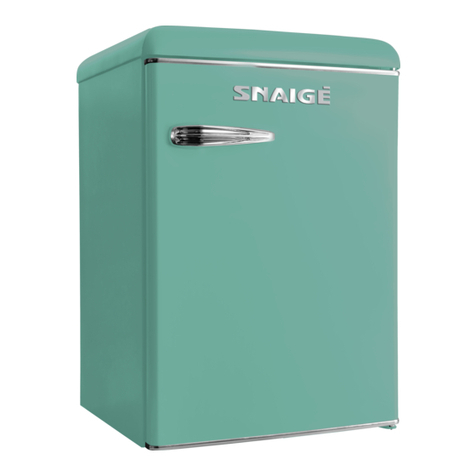
SNAIGE
SNAIGE R 13SM User manual

SNAIGE
SNAIGE MD40DC User manual

SNAIGE
SNAIGE RF31SM User manual

SNAIGE
SNAIGE C 14SM User manual

SNAIGE
SNAIGE R 13SM User manual

SNAIGE
SNAIGE FR27SM User manual

SNAIGE
SNAIGE FR240 User manual
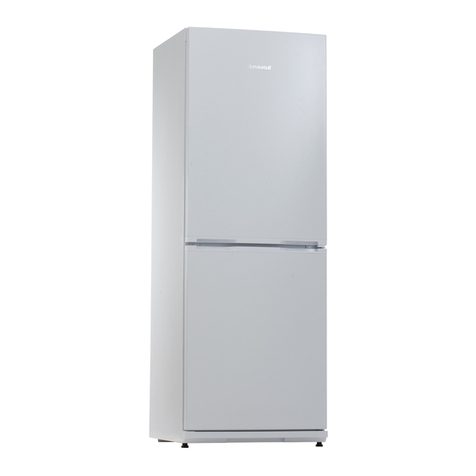
SNAIGE
SNAIGE RF27SM User manual
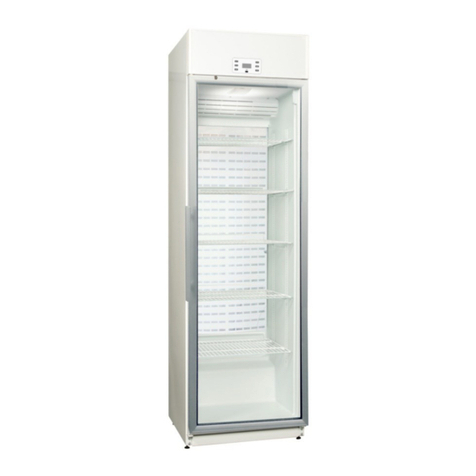
SNAIGE
SNAIGE MD40DD User manual
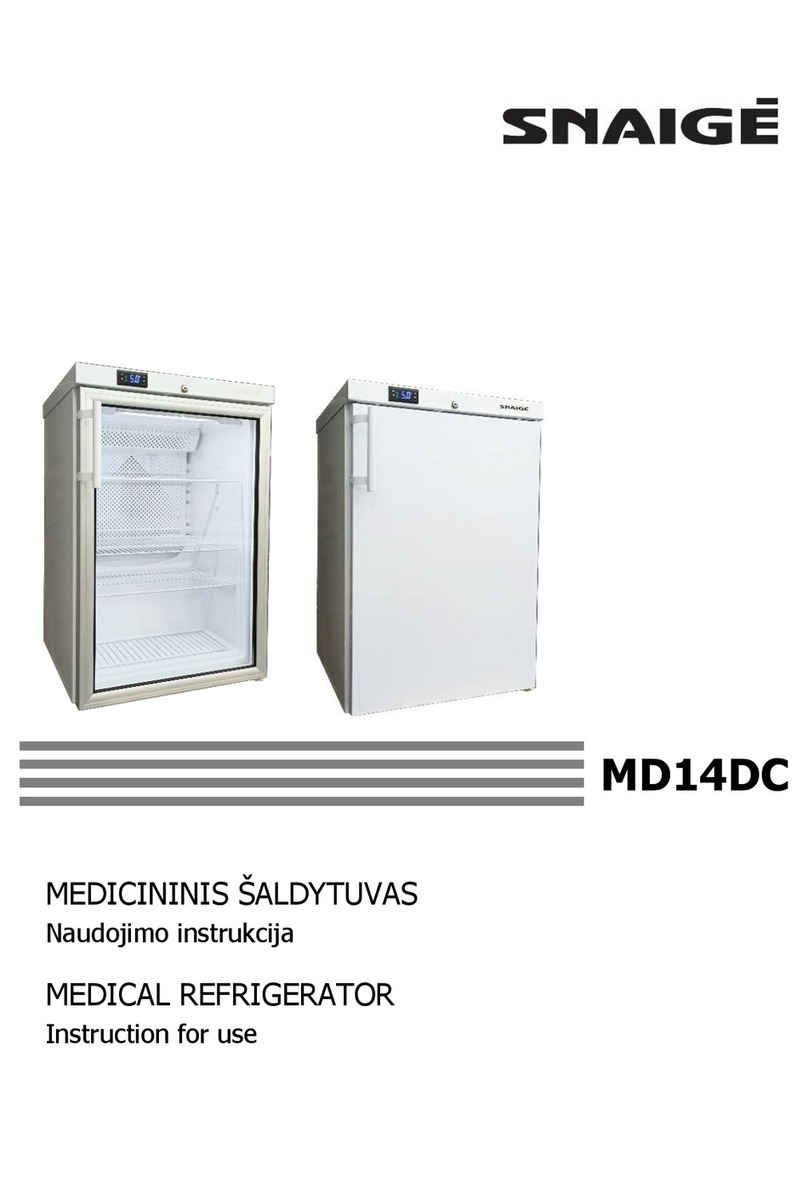
SNAIGE
SNAIGE MD14DC User manual

SNAIGE
SNAIGE C 29SM User manual

SNAIGE
SNAIGE Fresh INN RF53SM User manual

SNAIGE
SNAIGE RF53SG User manual
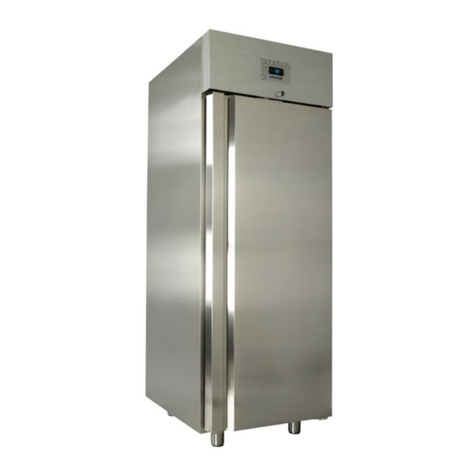
SNAIGE
SNAIGE CC70MF User manual
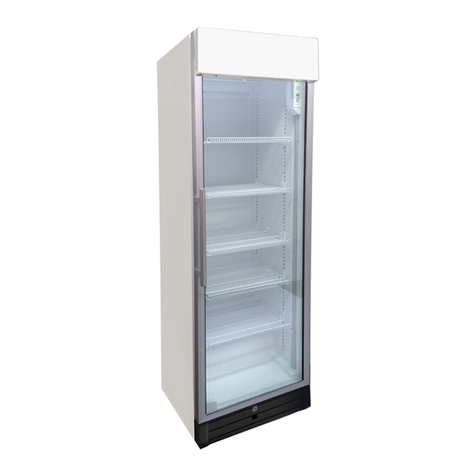
SNAIGE
SNAIGE CD48DM-S300BD User manual

SNAIGE
SNAIGE SGM020P2AA Series Manual
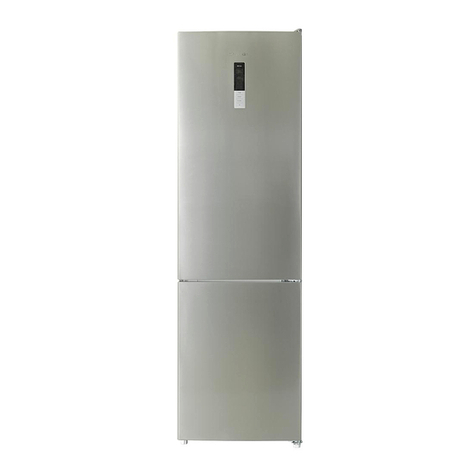
SNAIGE
SNAIGE RF62FB-TNCBNE0 User manual
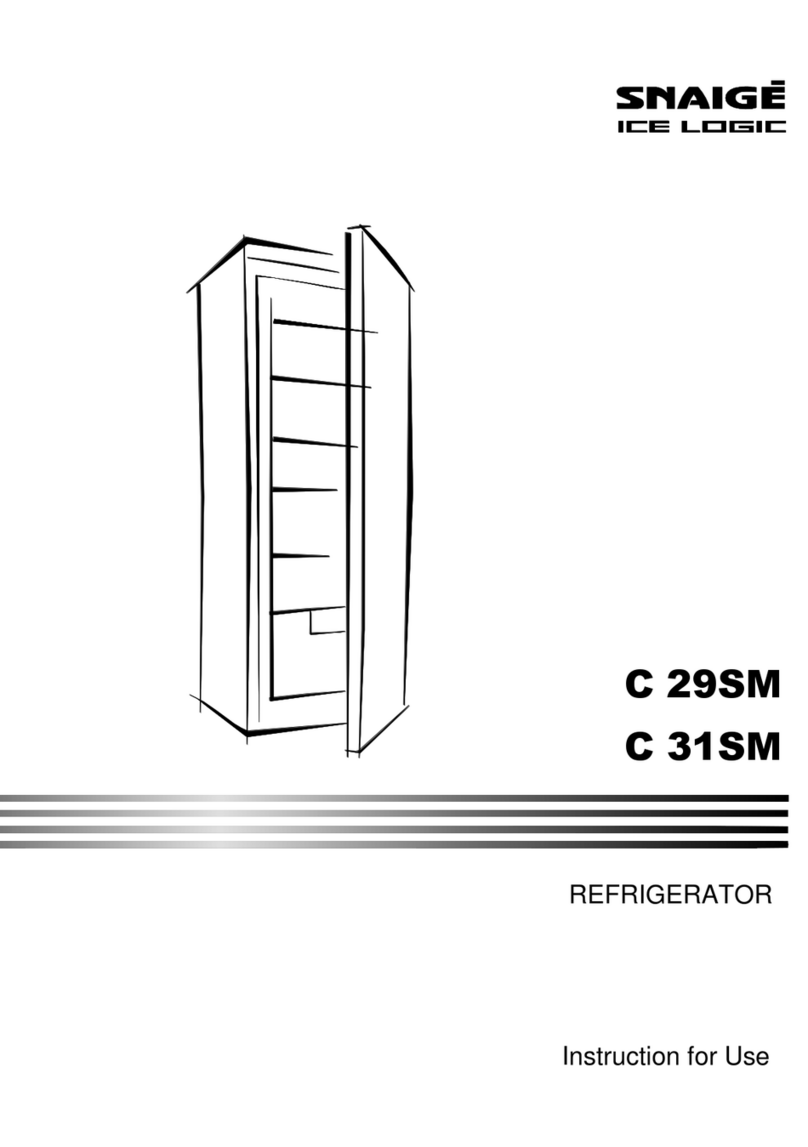
SNAIGE
SNAIGE C 31SM User manual

SNAIGE
SNAIGE WD35SM User manual
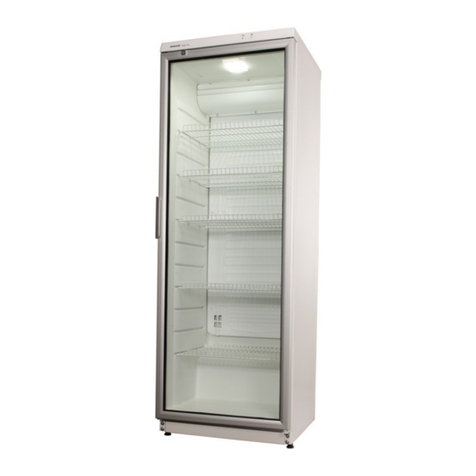
SNAIGE
SNAIGE CD29DM User manual

